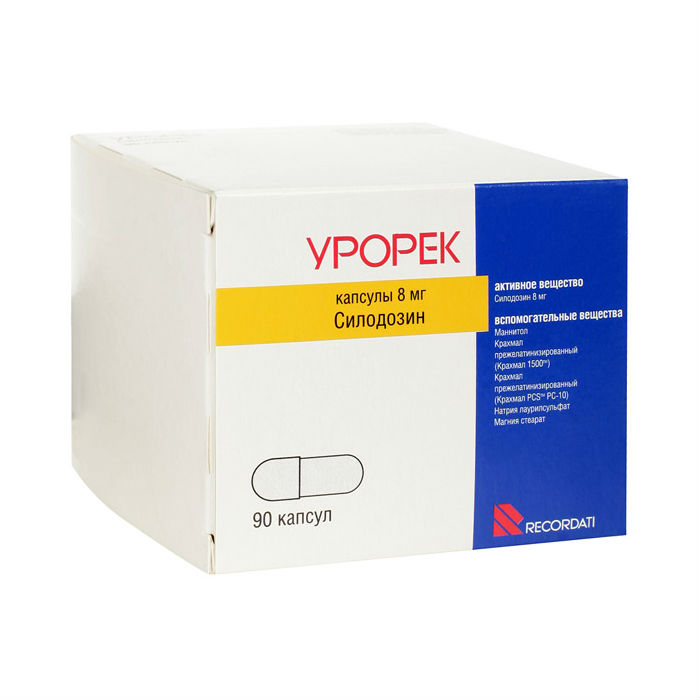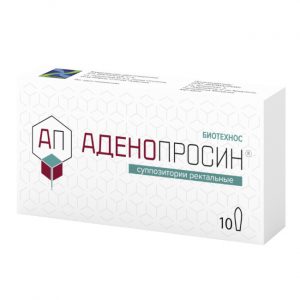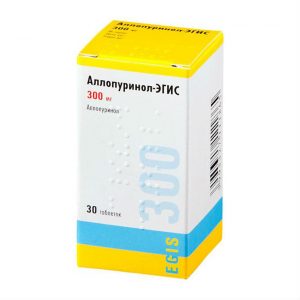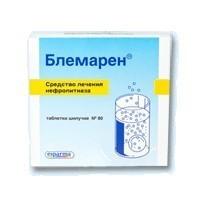Description
Pharmacological action
Pharmacodynamics.
Mechanism of Action
Silodosin, a highly selective competitive alpha 1a-adrenoreceptor antagonist, blocks postsynaptic alpha 1a-adrenergic receptors located in the smooth muscles of the prostate gland, bladder neck and prostatic urethra. Reduces the tone of the smooth muscles of the prostate gland, bladder neck and prostatic urethra, improving urine outflow. At the same time, the symptoms of obstruction and irritation associated with benign prostatic hyperplasia are reduced. Affinity for alpha – 1a-adrenergic receptors located in the bladder are 162 times greater than its ability to interact with alpha-1b-adrenergic receptors, which are located in the smooth muscles of blood vessels. Due to its high selectivity, it does not cause a clinically significant decrease in blood pressure (BP) in patients with initially normal blood pressure.
Pharmacokinetics
When taken orally, silodosin is well absorbed. Absolute bioavailability is 32%. Food reduces the maximum concentration (Cmax) by about 30%, increasing the time to reach the maximum concentration (tmax) to about 1 h and has a minimal effect on the area under the concentration-time curve (AUC). Cmax87 В± 51 mg / ml, tmax – 2.5 hours, the average concentration in the urine of 433 В± 286 ng * h / ml. The volume of distribution of silodosin is 0.81 l / kg and binds to plasma proteins by 96.6%. The binding of silodosin to carbamoylglucuronide by plasma proteins is 91%. Silodosin is metabolized by glucuronidation (involving UGT2B7), involving alcohol dehydrogenase and aldehyde dehydrogenase, oxidative pathways, mainly involving CYP3A4. The main active metabolite in plasma, carbamoyl glucuronide (K.MD-3213G) reaches a plasma concentration 4 times higher than silodosin itself. Silodosin does not have the potential to induce or inhibit cytochrome P450 isoenzymes.
33, 5% of silodosin is excreted through the kidneys and 54.9% through the intestines. The clearance of silodosin is about 23.1 l / h. Silodosin is excreted mainly in the form of metabolites and in a very small amount unchanged in the urine. T1 / 2 of silodosin and carbamoyl glucuronide is 11 hours and 18 hours, respectively.
Pharmacokinetics in various patient groups
Elderly patients: the pharmacokinetics of silodosin and metabolites were not significantly dependent on age. Silodozin clearance did not change in patients older than 75 years. Patients with impaired liver function: In patients with moderate impaired liver function (7-9 points on the Child-Pugh scale), the pharmacokinetics of silodosin are not significantly changed. In patients with severe hepatic insufficiency, the pharmacokinetics of silodosin have not been studied.
Patients with impaired renal function: For patients with moderate renal failure, no dose reduction was required. For patients with severe renal failure, the use of silodosin is not recommended.
Indications
Benign prostatic hyperplasia
Contraindications
Hypersensitivity to the active substance or any of the auxiliary
components or their intolerance
Children under 18 years of age
Severe renal failure (creatinine clearance less than 30 ml / min)
Severe mild liver disease and moderate renal failure (creatinine clearance from 30 to 50 ml / min).
Special instructions
As with other alpha1-blockers in the treatment with silodosin, a decrease in blood pressure, orthostatic hypotension can be observed. At the first signs of orthostatic hypotension (dizziness, weakness), the patient should sit down or lie down and remain in this position until the symptoms of orthostatic hypotension disappear.
Since benign prostatic hyperplasia and prostate tumors have similar symptoms and can develop together, patients with suspected benign prostatic hyperplasia need to be examined before prescribing to rule out prostate tumors. Treatment with Urorek® leads to a decrease in the amount of seminal fluid that can affect male fertility. This effect disappears after you stop taking Urorek®.
Patients taking or taking alpha-blockers during surgery for cataracts may experience flabby iris syndrome, which can lead to complications during surgery. It is necessary to stop treatment with alpha ^ adrenergic blockers 1-2 weeks before such an operation. Patients who are prescribed surgery for cataracts are not recommended to start treatment with Urorek®,
. There have been no studies of the effect on the ability to drive vehicles and equipment. However, patients should be informed of the possible manifestations of symptoms associated with orthostatic hypotension (e.g., dizziness), and should also be warned that that you should refrain from driving vehicles and equipment until you determine the individual tolerance of the drug Urerek® by the patient.
Composition of
1 capsule contains:
Active ingredient: silodosin – 8 mg
Excipients: mannitol – 264.8 mg, starch gelatinized (gelatinized) (1500 gelatinized, starch-gelatinized (gelatinized) PC-10) – 52 mg, sodium lauryl sulfate – 3.6 mg, magnesium stearate – 3.6 mg
Composition of a gelatin capsule: gelatin – 98 mg, titanium dioxide – 2 mg.
Dosage and administration
Recommended dose – 8 mg once, at the same time as food, preferably at the same time of the day. It is necessary to swallow the whole capsule, preferably with a glass of water.
For the treatment of patients with moderate renal failure (creatinine clearance> 30 – <50 ml / min), it is recommended to take an initial dose of 4 mg per day during the first week, with good individual tolerance, then you can increase the dose to 8 mg per day. Side effects Adverse reactions with an indication of frequency are given below: very often:> 10, often: from> 1/100 to <1/10, infrequently: from> 1/1000 to <1/100, rarely: from> 1 / 10,000 to <1/1000, the frequency is unknown (the available data do not allow determining the frequency). Nervous system Often: dizziness. Frequency unknown: syncope Cardiovascular system Often: orthostatic hypotension. Respiratory system Often: nasal congestion. Gastrointestinal tract Often: diarrhea. Infrequently: nausea, dry mouth. Reproductive system Very often: retrograde ejaculation, anejaculation Infrequently decreased libido, erectile dysfunction Intraoperative cider Frequency unknown: Intraoperative flabby iris syndrome during cataract surgery. Overdose Symptoms: marked decrease in blood pressure, compensatory tachycardia. Treatment: gastric lavage, taking activated charcoal or an osmotic laxative, symptomatic therapy aimed at increasing the volume of circulating blood (BCC), vasoconstrictor drugs. Monitoring kidney function. Dialysis is ineffective due to the intense binding of the drug to plasma proteins. Expiration 2 years. Terms and conditions prescription Dosage form capsules




